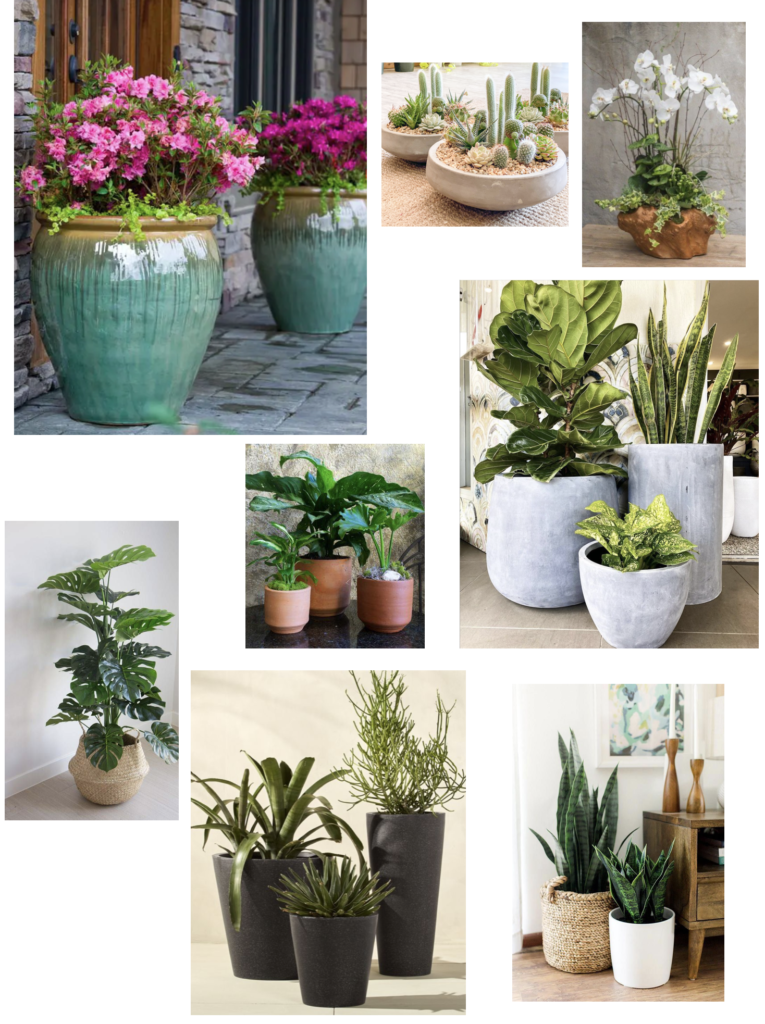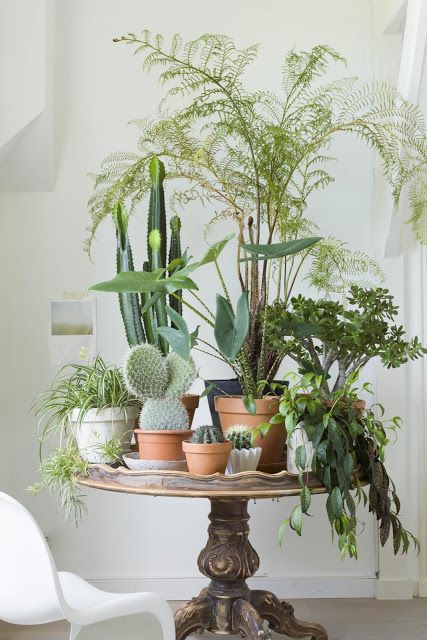Whether indoors or outdoors, on your patio or balcony, adding plants or flowers in planter pots are the perfect natural accent to your space. It’s well documented that plants have a positive impact on your mental and physical well being by purifying the air and bringing living energy to your space. Your choice of planter pots with greenery or flowering plants act like a piece of furniture; they help to define your space, add height, colour and ambience. A beautiful planter pot is the finishing touch you need to elevate the look of not only the precious plant it houses, but the space it occupies. With a wide variety of pots to choose from here are some tips on choosing the ideal planter pot for your home be it indoors or out!

How To Choose Your Planter Pot
First things first, you need to decide on plant size to figure out what planter pot will be best. Will it be a large stand alone plant, or will it be something small for a table top? To emphasize height a tall planter pot will be best and for smaller plants you size accordingly.
In terms of style, do you want your pots to stand out or blend into the background. For drama, go with planters in a bold or dark colour or try ones that are very textured with relief patterns and oversized. Neutral, muted or clay colour pots let your plants take centre stage.
Traditionally planter pots are generally made of clay and can be left unfininished or glazed. The benefits of clay is that it’s a breathable material so it promotes airflow and allows for healthy roots. Unfinished clay pots are porous so there’re best for outdoor spaces. Glazed planter pots are waterproof so are ideal indoors as well as outdoors. However, glazed and unglazed clay pots are subject to cracking over time.
Alternatively, there are resin type plastic pots that are not porous, so airflow is impaired but they are virtually indestructible and come in a variety of shapes and sizes.
The shape of your planter is also something to take into consideration. Square and rectangular planters convey a more contemporary, ordered look whereas rounded planters feel less structured and more organic.
Scale is important, especially in outdoor areas. When you have a large outdoor area to work with, grouping your planters by size, especially in groupings of 3, staggering small, medium and large planters is a tried and true way to achieve a beautiful setting. Mixing plant varieties in plant groupings also adds lots of dimension.
Consider drainage to keep your plants healthy. If you’re using a pot indoors without a draining hole, adding gravel to the bottom of the pot ensures the roots won’t rot.
Think outside the box, anything that can contain your plant can be used as a planter pot, like baskets or bowls for example. Just be mindful of drainage issues and make the necessary allowances.
 *All stock photos courtesy Pinterest
*All stock photos courtesy Pinterest
Faux Plants: Are You For Real?

The faux plants of today are not your grandmother’s. They are very realistic and are great for indoor use.
Faux plants allow you to incorporate plants into your decor that aren’t readily available or very expensive.
Faux plants are low maintenance and won’t die on you. But they do need some tweaking to show them to their best. Open out branches, bend stems and shape foliage and leaves to replicate the look of real ones.
Faux plants generally come in a basic black pot. Simply place it within another pot that suits your decor to upgrade the look. Also, you can fake the true height of your plant by raising it within the new pot by adding bricks, stones or something firm it can sit on.
Add moss or pebbles around the base of your container to hide the basic pot of your fake plant for a more realistic look.
Even though faux plants can’t purify the air like real ones do they still can have a positive impact on your mood as they trick the brain with their realism and lifelike qualities.
Q&A with Liola Harvey of Garden Gems
In order for plants to survive in your space, you must take into account the environmental conditions necessary for their survival, like sunlight, water, soil type, maintenance etc. I know a lot of us don’t have a green thumb, so we sat down with local gardener extraordinaire Liola Harvey of Garden Gems along with her two daughters Hayle and Thia to ask them for their advice, along with helpful tips to guide us when it comes to choosing plants and flowers for container gardening.

Q. Welcome Liola, it looks like this is a family affair, please tell its about yourself and how Garden Gems came about?
A. I have been a lover of plants and flowers for as long as I can remember, and along with my two daughters Hayle and Thia, we have created a tranquil garden experience like none other. From cacti and succulents to roses, indoor and outdoor plants, and even herbs, there is a little bit of everything. For them this was a hobby. Every few days, there was a new plant or plants coming to find its spot in the garden. Eventually, it turned to a small business – Gardens Gems.
Q. What plants do you recommend for indoor spaces? We need the low down on the ones that can withstand “neglect”? Lol!
A. For starters, we have to remember that one of the most essential things a plant requires for healthy growth is sufficient light! Therefore, when considering houseplants, first consider the location and the amount of light the plant will receive. We generally recommend plants that can tolerate low light like Sansevierias (Snake plant/Mother-In-Law’s Tongue), palms, spider plants, Zamioculcas Zamiifolia (known as the ZZ plant), dieffenbachia and aglaonemas. Sansevierias and ZZ plants also require very little watering. How’s that for plants you can pretty much “neglect”! Lol!
Q. And for outdoors, is it true that those are generally less fussy plants to take care of?
A. For the outdoors you can consider a wider range of plants. If you are a beginner, we would suggest something like elephant ears, cactus plants or …. for more experienced plant enthusiasts, we would suggest from a range of monsteras, begonias, philodendrons or even a succulent.
Q. What about soil mix- how important is it to get it right? Should you buy potting mix or take soil from your garden?
A. The soil mix you use in your plants is very important. One must know the conditions that your plant requires for optimal growth and health. Plants require nitrogen, phosphorus, and potassium, as well as other micronutrients to grow. The soil that you use should have nutrients available for your plant. Your soil mix should also be able to retain sufficient water to keep the plant hydrated between waterings. Your soil mix should also drain well. Heavy or compact soil may cause your plant to retain too much water and cause root rot. The soil’s root development depends on the quality of soil that your plant has. An ideal soil mix provides a balance between porosity and density, allowing the roots to develop and spread out. Keep these things in mind when creating your soil mix.
Q. Watering and getting it right? we’ve heard about sticking your finger in the pot to determine moisture levels, is this a good guide to use?
A. Knowing your plants watering requirements and knowing when to water your plants are extremely important. Checking the soil moisture prior to watering may help you determine if it is time to do so. You can use your finger for smaller pots or a skewer or chopstick for deeper pots. Just use it like you would with a cake! We haven’t tried it yet, but there are also moisture meters. When we do, we will be sure to report. When watering your plants, it is best to water thoroughly allowing the soil to soak up water and drain out of the pot. Watering your plants less often, but thoroughly will allow it to develop a stronger root system. Be sure to use room temperature water on your plants as water that is too cold, or too warm can shock and damage your plants. Observe your plants and adjust watering as necessary. Also remember that under watering your plant, can affect it just as much as overwatering.
Q. Sunlight needs, guess you just have to read up on this to know your plant’s needs? We’ve read about south facing or north facing windows or openings being good areas to position your indoor plants, can you explain? Or do you have an easier suggestion on where best to position your plant?
A. Some plants prefer direct sunlight, while others prefer indirect or filtered light. Research the sunlight needs of your specific plant and try to provide the appropriate amount of light. Observe your plant regularly to see how it is responding to the sunlight. If the leaves are turning yellow or brown, it may be getting too much sun. If the leaves are pale and the plant is not growing well, it may not be getting enough sun. If you notice that your plant is not thriving, adjust the amount of sunlight it is getting. Move it to a sunnier or shadier location as needed. It may take some trial and error to find the right spot for your plant. Lastly, be mindful that the sun may be stronger or weaker in an area based on the time of day, and time of year.
Q. What are the most common problems with indoor plants and how to troubleshoot?
A. One common problem that immediately comes to mind, and that leads to other problems is lack of drainage holes in pots. Please make sure your pots have drainage holes so water can seep out after watering. Lack of drainage holes, can keep the soil wet or too moist and neither are good for your plants. Another problem is overwatering. A plant with wet or even damp soil often does not need to be watered again. Be mindful that you do not want to drown your plant’s roots. If you find a plant with root rot, remove it from the soil, let it sit for a few hours to days (depending on the type of plant) then repot it using soil that allows for ample drainage. Sometimes too much water may just kill a plant, if it is one of those that doesn’t grow by a cutting. Most houseplants need bright, indirect light to thrive. If a plant is not receiving enough light, it may become leggy or develop yellowing leaves. Move the plant to another location and observe it for improvement. Remember, sometimes it may take a while to find the right spot. Also remember, that sometimes that spot may be outside! Houseplants are prone to a variety of pests, including spider mites, mealybugs, and aphids. These pests can cause damage to the leaves and stem of the plant, and can be difficult to eradicate. These pests all require different approaches to treating them but firstly quarantine your plant to stop the spread to other plants. Research your pest problem for specific treatment options.
Q. We all love orchids, are they really easy to take care of in indoor environments?
A. We do not have many of our orchids indoors. Orchids are generally very sensitive plants. Here are some tips for orchid care.
- Orchids should be watered once a week, or when the potting mix feels dry to the touch. Water thoroughly, allowing the water to drain out of the bottom of the pot. Do not let the orchid sit in water, as this can cause root rot.
- Orchids prefer bright, indirect light. Avoid direct sunlight, as it can scorch the leaves. A north-facing window is often ideal.
- Orchids prefer high humidity levels. If your home is dry, consider placing a tray of water near the orchid or misting the leaves.
- Avoid placing them near hot areas or cooling vents.
- Prune orchids after they have bloomed. Cut back the flower spike to just above the first node, new growth should appear within a few months.
Q. I know some plants are toxic to pets, so which ones should we avoid if we have pets?
A. There are so many plants that are toxic to our pets. Let’s first hope that our pets will not interfere with our plants. Train them not to interfere with your plants. In any case, here are a few plants that are toxic to pets; all parts of lilies, aloe vera, poinsettias, ivy, peace lilies, kalanchoes, pathos, schefflera, monsteras, alocasias and some begonias.
Q. Any additional advice you’d like to share?
A. We can offer advice that may not always be the answer to your problem as there are so many ways to care for plants. Here’s some quick advice we would like to give not just to new plant owners, but also to plant lovers:
- Research your plant: Find out your plant’s growing requirements including light, water and soil. Knowing what your plant needs to survive and thrive will set the tone for achieving a healthy plant collection.
- Consider the environment and/or space you intend on placing your plant. Remember that each plant has its own requirements but also consider that each plant will behave differently based on its environment. (E.g. A plant’s soil mix may dry out quicker in one area than it does another.)
- All plant parents will experience plant problems. There are lots of ways to remedy plant problems and there may be several factors to consider. Finding what works for your plant is what is important. Do some research and then adjust accordingly to get your plants back on a healthy track.
- Have fun with your plants. This can range from just sitting in the peace of your plants, repotting, switching up new pots and planters or creating a plant aesthetic that you want. Let your plants be a peaceful escape and not a chore.
